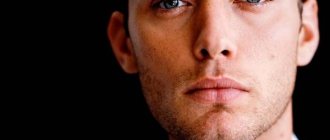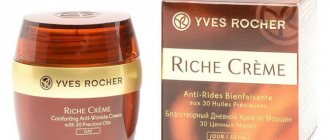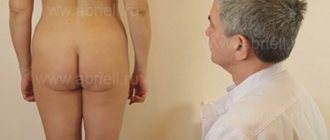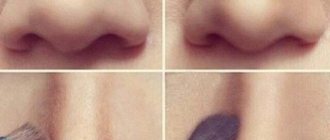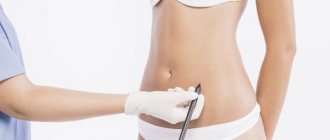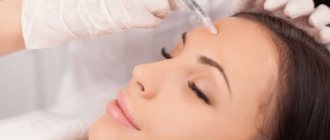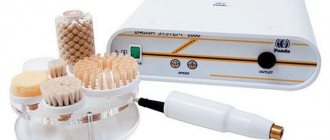The essence of the technique
Cheek plastic surgery is a process of changing the cheekbone area and cheeks in order to give this part a more aesthetic appearance. Correction is performed in several ways: through surgery (malarplasty), injections (contour plastic with fillers), and liposculpture.
Efficiency
What effect can be achieved:
- restore facial contours;
- lifting;
- smooth out nasolabial folds;
- reduce cheeks, cheekbones;
- smooth out wrinkles;
- add volume to sunken cheeks;
- get dimples on your cheeks.
Malarplasty can change your appearance for the better, but it will not eliminate deep wrinkles. Removing Bisha's lumps will give the effect of sunken cheeks to those with a thin face. If the face is round and full, such an operation will not greatly affect its contours and the desired result will not be achieved.
Cheek plastic surgery is allowed from the age of 18. But at this age it is recommended for congenital or acquired defects on the face. If you need a lift, removal of Bisha's lumps, or plan to combat age-related changes, cosmetologists recommend doing malarplasty after 35 years, and contour plastic surgery - from 30 years. For early signs of aging, earlier correction is allowed after 25 years. But after 55 years, it is better not to resort to cheekbone surgery, as the risk of complications increases.
Attention! Age restrictions for malarplasty are not strict indicators and are advisory in nature. The decision about plastic surgery is made in each individual case.
Dimples
Cheek dimples are a genetic defect in which a separate bundle of the zygomaticus major muscle (lat. m. zygomaticus major) is separated and attached to the dermis, and thus, when the muscle is tense, a depression is formed, that is, the muscle bundle pulls part of the skin of the cheek along with it. This is most noticeable when smiling and on chubby cheeks, since the fat layer is more pronounced there.
This structural feature of the facial muscles does not affect their work in any way, but creates a cute, childish facial expression that is attractive. This anomaly is transmitted genetically and has a dominant nature, that is, if your parents have dimples, you will have them.
Society has a positive attitude towards those with dimples. They are called "angel's kiss" or "sign of happiness." It is believed that those with this defect are more successful and happy people. Dimples on the cheeks give the face a more youthful appearance. They can be of any shape, asymmetrical and even only on one cheek. With age, dimples may disappear, this is due to thinning of the fat layer and stretching of the muscles.
Those who were not born with dimples can have a simple dimpleectomy surgery.
Preparation
Since malarplasty of the cheekbones requires surgical intervention, the patient is thoroughly prepared for it in order to check the state of health, the presence of contraindications, and give several recommendations.
When visiting a plastic surgeon, the following issues are resolved:
- based on the patient’s complaints and wishes, the doctor gives recommendations on future cheekbone surgery - which technique to choose, where correction is really needed, and if surgery is not necessary, he must inform the patient about this, giving reasons for his point of view;
- the doctor finds out how psychologically the patient is ready for future changes;
- modeling of future facial contours is created using computer programs and coordinated with the patient;
- Further examination is being carried out.
What must be done:
- fluorography;
- Clinical blood and urine analysis;
- biochemical blood test;
- electrocardiogram;
- examination for infectious diseases - a conclusion is issued about the absence of HIV infection, hepatitis, sexually transmitted diseases;
- examination for blood clotting, Rh factor, group;
- coagulogram;
- visiting an anesthesiologist;
- gynecologist's report for women.
Recommendations to follow before surgery:
- 3 weeks before malarplasty, stop drinking alcohol, taking anticoagulants, oral contraceptives, and anti-inflammatory drugs;
- eating food is prohibited 6 hours before surgery;
- Half an hour before malarplasty, premedication is done - the administration of a sedative, antiallergic and narcotic painkiller in one syringe or tablets.
Progress of the procedure
The plastic surgeon examines the face and makes marks with a marker. The operation is performed under local anesthesia (lidocaine, ultracaine or novocaine). The operation is performed on the mucous side of the cheek, so there will be no visible scars on the skin. The surgeon disinfects and cuts the mucous surface of the cheek, partially removes the fatty tissue and excises a small piece of muscle, fixes the muscle with self-absorbable suture material, creating the effect of a dimple on the cheek, then sutures the incision and sends the patient home with recommendations for wound care. The operation lasts on average 30-40 minutes.
Kinds
To achieve the desired effect, surgical plastic surgery of the cheekbones is divided into 2 types.
Reducing
Softens facial features, making it narrower, corrects a wide jaw. To achieve this goal, different techniques are used.
Liposuction
During the procedure, fat is broken down and removed from the body. The splitting is carried out by introducing a special solution, after which the prepared fat is sucked off by vacuum. The disadvantage of this method of cheekbone correction is that it can lead to excessive sagging of the skin, so plastic surgeons recommend a more effective procedure - laser liposuction. In this case, fat deposits on the cheekbones are removed using a laser, and then with its help, subcutaneous cells are burned, provoking collagen synthesis and cellular renewal.
Thanks to laser treatment, the face becomes thinner and the skin tightens. Rehabilitation includes a two-week home regimen. It is not recommended to lose or gain weight sharply at this time.
Important! The operation requires high professionalism of the doctor, since you need to know exactly where the trigeminal and facial nerves are located. Incorrect directions of the laser beam can damage them.
Malyarplasty
The goal is to reduce the cheekbone. It is carried out by partially cutting down the bone tissue by grinding or by shifting the desired part of the cheekbone inward using reposition or osteotomy. The operation is classified as severe, occurs under general anesthesia, lasts several hours and is followed by a long rehabilitation period - up to 6 months.
Removing Bisha's lumps
This plastic surgery of the cheekbones is carried out with the aim of reducing the lower third of the face by removing special fatty formations from the cheek area - Bisha's lumps. The operation is allowed after the age of 25, since it is believed that before this time the shape of the cheekbones can change naturally and this type of plastic surgery will not be required. In addition, surgeons warn that after a few years, cheeks without lumps that fill the shape of the frame may simply “fail” and the effect of a haggard, aged face will be obtained.
Check-lifting (cheek lift)
This is done in two ways:
- superficial - during the operation, a thin layer of fatty tissue is corrected and the skin is tightened;
- deep - the muscle frame SMAS (superficial muscular aponeurotic system) is worked out. The results of this procedure are longer lasting, but if the doctor is inexperienced, there is a risk of damage to the facial nerve.
Dimpleectomy
This type of plastic surgery is used by those who want to get dimples on their cheeks. The operation is performed under local anesthesia. An incision is made through the mucous membrane on the inside of the cheek in the area where the natural cavity of the zygomatic muscle forms. The dimple itself is formed by a surgical thread, which is used to tighten the soft tissue in the area designated for the dimple. At first, such a dimple is visible even in a relaxed state, but after 1–2 months the muscles are completely restored and the dimple becomes noticeable only when smiling. Before a dimpleectomy, the surgeon warns the patient that the operation process is irreversible and it will not be possible to get rid of the dimples in the future.
Magnifying
This kind of cheekbone plastic surgery is used for the purpose of facelift, correction of the upper part of the face in places where depressions form, etc. There are several types.
Implantation
A type of malarplasty that involves the introduction of implants into the corrected part of the cheekbones in order to give them the desired shape. The implants themselves are made from materials biologically compatible with human tissue (silicone, bone tissue) and are installed for a long time. Cheekbone augmentation surgery is performed under local or general anesthesia. All interventions are carried out in two ways:
- through the mouth - an incision is made through which the implant is installed, so signs of plastic surgery will not be visible from the outside;
- the incision is made from the outside in the temple area, behind the ear, and in this case the seam will be covered with hair.
Lipofilling (liposculpture)
It includes two operations: liposuction and lipofilling. During liposuction, material is taken from the patient's own fat tissue. The resulting fat is processed and injected under the skin of the face using cannulas. The advantages of the technique are that such fillers restore the shape of the cheekbones and improve complexion. The disadvantages include the possibility of inflammatory reactions, the formation of benign cysts, and partial resorption.
After the operation, the patient needs to stay in the hospital for 1–2 days. Swelling goes away within 7–10 days. The final result is noticeable after 3 months. At this time, you can see how well the fat has been established, what part of it has resolved, etc. If necessary, additional correction of the cheekbones is done.
What is dimpleectomy
Dimple-ectomy is a minimally invasive plastic surgery that creates symmetrical hollows on the cheeks. The operation can be performed by anyone with any cheek shape and fullness. The dimples can be made deep, shallow, round, or elongated. The procedure is considered easy, is well tolerated and has a short recovery period. Why do people want dimples? To answer this question, let's look at how they are formed and why people like them.
How is the operation performed?
Malarplasty is performed under anesthesia:
- local - when anesthetics are injected into the site of future treatment, the patient additionally takes sedatives;
- general - accompanied by tracheal intubation. Anesthesia is administered intravenously, the patient can be connected to an oxygen supply apparatus, as well as to a monitor where the anesthesiologist monitors his condition - pressure, pulse, respiratory rate, blood oxygen saturation.
General anesthesia enhances the effect of antiseptics. The decision about what type of anesthesia to use is made by the anesthesiologist in preparation for the operation.
Types of cuts
Depending on the type of cheekbone plastic surgery, the incisions can be:
- internal - done in the mouth, in the area of the alveolar process of the upper jaw;
- external - located from the temple behind the ear, on the side where the seam is covered by hair.
Stages of the procedure
During surgery, the procedure is as follows:
- Anesthesia. Here we wait until it begins to act.
- Disinfection. The area where malarplasty will be performed is treated with an antiseptic. If incisions are made on the mucous membrane, dilators are placed in the mouth.
- Incisions are made and the cheekbones are corrected - Bisha's lumps are removed, implants are inserted, part of the tissue is excised, or a lift is done to give the desired shape. During the procedure, the first stitches may be placed.
- After this, the incision is completely sutured with surgical threads and re-treated with antiseptics.
- If it is necessary for the tissues to grow together between the resulting voids, a tight bandage is applied in this place.
The duration of the operation depends on the type, course and anesthesia used. On average, its duration is half an hour or more. The time increases if the malarplasty is complex, requires changing the shape of the bones, etc.
Attention! Any type of cheekbone plastic surgery is fraught with serious complications if performed incorrectly. Therefore, you need to resort to correction only in a proven clinic with a good reputation and choose a doctor with extensive experience and high qualifications.
Dimples are not only on the face, but also on the body
Even with all the types of facial dimples a person can have, dimples are not limited to just the cheeks, chin, or even the corners of the mouth. They may actually occur in other areas of the body. Some people have two notches on their lower back. These dimples on the back, called "pits of Venus", as well as dimples on the chin, cheek and mouth, are believed to be a genetic inheritance.
Angelika Varum decided to learn a new sport during the New Year holidays
Moscow has become the leader in traffic jams: 2021 study
A complete hassle: which zodiac signs will quarrel with their relatives in 2021
Photos before and after
Rehabilitation period
Immediately after cheekbone surgery, a rehabilitation period begins. At this time, the face swells, the patient feels a burning sensation, skin tightness due to swelling, pain, and discomfort. The hardest days are the first three days. The rehabilitation period can last up to six months. It all depends on the complexity of the operation. The hardest thing to recover from is surgery on bone tissue.
Peculiarities:
- at first you need to stay in a hospital, after discharge - under the supervision of loved ones;
- after malarplasty, a course of antibiotics is prescribed for 3–5 days;
- During the first 3–4 days, severe pain persists, so taking painkillers is allowed;
- sutures in the mouth heal quickly - within 3-4 days, but swelling persists longer - from two weeks to 3 months;
- during intraoral intervention, you should rinse your mouth with an antiseptic solution several times a day for 4–5 weeks;
- external sutures are processed according to the surgeon’s recommendations;
- to speed up the process of disappearance of edema, decongestant and anti-inflammatory drugs can be prescribed, most often Traumeel S;
- until the swelling disappears, it is recommended to sleep on a high pillow, avoiding a face-down position;
- Hardware procedures—microcurrents—can also be prescribed to speed up healing.
On average, the result after cheek surgery lasts about 10 years. Correction of cheekbones, removal of Bisha's lumps, dimplectomy remain unchanged throughout life. Scars do not completely dissolve, but they are almost invisible and do not cause any discomfort.
Rehabilitation
The rehabilitation period lasts from 2 weeks to 1 month.
After surgery, you may experience some discomfort and pain during the first week. To relieve this condition, you can take painkillers, such as paracetamol or ibuprofen.
You need to rinse your mouth with antiseptic solutions and/or herbal infusions of chamomile, sage, oak bark throughout the day and always after eating.
You need to brush your teeth carefully so as not to injure the wound surface. Preference should be given to soft, warm, grated food. For the first 2-3 days, you can eat food from baby jars or make yourself liquid porridge.
Your doctor may prescribe antibiotics to prevent the wound from becoming infected.
When should you see a doctor?
All suture material used in the operation is self-absorbing, so there is no need to remove the sutures. You will need to visit your doctor for follow-up 3 days, 1 week and 3 months after surgery.
Where is it made and cost?
Malarplasty and contour plastic surgery of the cheekbones are done in special clinics with permission to carry out such interventions. It is better to consult a doctor with experience, who is well versed in the nuances of the procedure, knows the structure of the face, the location of nerves and blood vessels. The cost of surgical plastic surgery of the cheekbones depends on the complexity of the intervention. The starting price is about 65,000 rubles. Bish's lumps can be removed at a cost of about 35,000 rubles. The price for a dimpleectomy is approximately the same.
Restrictions after surgery
To avoid complications you should:
- at first, eat liquid and viscous foods - cereals, jelly, soups, etc., avoiding solid foods;
- after surgery, you should not eat hot, spicy or sour foods through the mucous membrane until the incisions are completely healed;
- For the first month, it is advisable to give up smoking and drinking alcohol - bad habits slow down the healing process;
- For the same period, visiting solariums, baths, playing sports, and excessive facial expressions are prohibited.
What complications can there be?
Depends on the type of correction.
Side effects after surgical cheekbone surgery are divided into 2 types:
- are common;
- specific.
General complications
Appear during any surgical intervention. These include:
- swelling;
- nausea;
- pain;
- bruises;
- numbness;
- scars at the site of sutures;
- dizziness;
- bleeding;
- allergy;
- inflammation.
Specific
They appear after malarplasty due to violations of the rules of the rehabilitation period, characteristics of the body, or due to the inexperience of the doctor.
It can be:
- infectious phenomena;
- implant rejection;
- facial asymmetry;
- pigmentation;
- chronic sinusitis;
- displacement of the zygomatic bones;
- paralysis of part of the face if the facial nerve is affected;
- incomplete functioning of the jaw area;
- tissue necrosis;
- sagging skin.
Complications can occur throughout the rehabilitation period, so until its completion it is important to be under constant supervision of the surgeon.
When is revision surgery required?
Repeated (revision) malarplasty is indicated if the following phenomena are observed after surgery:
- asymmetry;
- there were no changes due to cheekbone surgery;
- sagging skin;
- implant migration, its instability;
- additional correction is needed.
It turns out that a dimple is equal to a royal title
Regardless, dimples have been attractive for a very long time. And for perhaps almost as long, people without dimples have been looking for ways to get attractive dimples on their faces. “Any woman who has been wronged by nature in the distribution of the dimples can correct the deficiency by surgical intervention,” reads an 1896 New York Herald. At the end of the advertisement, everyone was warned that after such an operation you may be left with an unsightly scar, or you may inadvertently get an infection.
However, all these warnings did not frighten those who wished to do so. And how did it work? In the 19th century, a special design was created that included a knife with a sharp blade, a tiny scoop and a thin needle. This miracle tool first cut the skin with a knife, where according to the marks there should be holes, then they pulled out the fat with a scoop and made a kind of “blank”, and then sewed everything up with a needle. What sacrifices for the sake of beauty!
Contraindications
Plastic surgery cannot be performed if the patient:
- infectious diseases of various origins;
- exacerbation of chronic diseases;
- allergic manifestations;
- disruption of the cardiovascular, nervous, endocrine and respiratory systems, including diabetes and hypertension;
- oncological diseases;
- metabolic disorder;
- blood diseases and clotting problems;
- skin irritation, rash at the correction site;
- pregnancy, lactation.
How to make dimples on your cheeks without surgery
Cheek dimples can be created without surgery using cosmetics. To do this, you need to use concealers and correctors to darken the middle and lighten the contour of the supposed depression. The effect of the presence of dimples on the cheeks will be visually created.
You can get piercings on your cheeks; dimples will visually appear at the piercing sites, and when you remove the earring, small indentations will remain on your cheeks.
Alternative Methods
Other techniques are also used to correct cheekbones.
Contour plastic surgery - use of fillers
During the procedure, gel-like fillers are injected into the areas where volume needs to be added. Most often, fillers based on hyaluronic acid and calcium hydroxyapatite are used for this.
The procedure does not last long - from 15 minutes to an hour. The duration depends on the location of the problem area, as well as whether anesthesia was used during the session or not. Advantages of cheekbone contouring:
- speed of the procedure;
- short and easy rehabilitation period;
- Over time, fillers dissolve;
- it is possible to neutralize hyaluronic acid in case of side effects.
The disadvantages of the method include the fact that the result lasts from 6 months to 3 years, then cheekbone plastic surgery with fillers is carried out again to maintain the effect.
Hardware therapy
It involves the effect of special radiation on the skin of the face:
- laser - the beam penetrates the subcutaneous tissues, injures them and stimulates the production of collagen, as a result of which the skin is rejuvenated, the contours of the cheekbones become more defined;
- radio frequency (RF-lifting) - during the procedure, the subcutaneous tissues are heated, as a result of which the collagen fibers contract and the facial muscles are tightened.
Cryolifting is also used - exposure of the dermis to extra-low temperatures (-20 degrees Celsius). This technique stimulates collagen production, strengthens blood vessels, relieves swelling, and removes toxins.
To achieve results, hardware cosmetology must be carried out in a course of at least 3 procedures. It is worth noting that such techniques can only rejuvenate and tighten the skin; dramatic changes in appearance do not occur after them.
Mesothreads
Thanks to this correction of the cheekbones, the facial frame is formed by introducing special cosmetic threads. Mesothreads are inserted using long needles with a blunt tip - a cannula. The effect lasts up to 2 years.
Plasmolifting
During the procedure, the patient's processed plasma is injected under the skin. The technique has a rejuvenating effect, improves metabolic processes, smoothes wrinkles, and promotes cell regeneration.
Gymnastics (face building)
An effective technique for strengthening facial muscles, shaping the contour, and preventing aging. To achieve results, you need to do special regular exercises for a long time.
Collagen injections
Collagen is a completely natural product. This is a structural protein that is produced by epidermal cells.
Young skin synthesizes this substance in sufficient quantities. It looks elastic and smooth, wrinkles are completely absent. Over time, the production of your own collagen decreases. This is what leads to the formation of scars, pits, scars, and changes in body contours. This gives people aesthetic discomfort.
The introduction of collagen filler rejuvenates and smoothes out skin irregularities. Injections relieve post-acne and restore the natural beauty of the face.
After the procedure, slight swelling may form at the site of drug exposure. Allergic reactions in the form of irritation rarely occur. After the injection, slight pain may occur. Within a day, the discomfort disappears. You will be able to enjoy the results within a week, when the swelling of your face completely disappears.
Experts' opinion
The expert in this review says that there are no age restrictions for plastic surgery of the cheekbones. But he emphasizes that after 70 years of age this type of surgical intervention is not recommended.
The popular operation to remove Bisha's lumps is not always indicated. The surgeon speaks about this when answering a question from a patient who wants to remove sagging cheeks.
The doctor from this review also warns about possible consequences after removing the lumps. The surgeon says that they support the muscles, and if before the age of 35 the operation gives the effect of a refined face, then after this age the muscle tissue relaxes, and the face looks haggard and tired. And then contour plastic surgery is needed - correction of the cheekbones with fillers. He also talks about lipofilling, warning that the injected fat can have side effects - inflammation and seroma.
If you don't have dimples on your lower back, you can make them
Modern researchers are sure that the popularity of the operation to acquire dimples in the lower back came along with social networks. Girls who see candid photos of Kendall Jenner also dream of getting this body feature in order to feel more attractive.
In 2021, plastic surgeon Amanda Wong-Powell, founder and medical director in London, offered her own procedure known as the "V-Spot" treatment. In an interview with the publication, she said: “For decades it has been known that dimples in the lower back are sexy. This is a symbol of prosperity and youth.”
The plastic surgeon's technique first involves liposuction. After fat is removed from two sections of the lower back where dimples typically occur, the area is treated. However, these fake dimples don't come cheap. At the beginning of 2021, this procedure cost more than 70 thousand rubles.
Patient reviews
The girl in this review talks about her well-being and the condition of her face a month after malarplasty. He says that there is some swelling left and sensitivity has not fully returned.
Detailed details of the girl’s rehabilitation period are here https://plastic-surgeon.ru/forum/showthread.php?t=14371
The patient shares her experience of removing Bisha's lumps in the following review. He says that even after 2 months he does not see the final result, as swelling is noticeable. According to the surgeon, the effect will only appear in 4–6 months.
The following patient talks about the sensations during the operation to remove Bisha’s lumps. He notes that the pain was tolerable, but it intensified slightly at the time of removal of fat pieces. The girl also says that the lumps themselves are also removed in different ways: on the one hand, it came out easily, but on the other hand, the surgeon had to tinker with it to remove it. Attached is a photo of the lumps themselves.
Details here https://irecommend.ru/content/foto-ne-dlya-slabonervnykh-o-tom-kak-prokhodit-plasticheskaya-operatsiya-i-posleoperatsionny
The patient in the following review felt well after the operation. She says that she immediately saw how her cheeks became smaller. But then severe pain appeared and I had to take painkillers. The next day there was severe swelling and the doctor prescribed Traumeel - ointment and tablets at the same time.
The patient was dissatisfied with the outcome of the operation to remove Bisha's lumps, she waited 2 months for the result and did not receive it. He believes that there is no effect from the operation.
Cheek surgery is a serious intervention that can change your appearance for the better. But in order for the result to turn out as desired, and after the operation not to become a victim of serious complications, you need to put your face in the hands of a highly qualified doctor who values his reputation, strives to do his job perfectly and is able to direct the patient’s desires in the right direction. After all, a person’s opinion about his appearance is not always correct, and an experienced surgeon will be able to point this out and offer an option that will be for the benefit of the client himself.
Possible complications
— The risk of complications is minimal, especially if the operation was performed by a qualified plastic surgeon.
— In the first days after surgery, slight swelling and hematomas may be observed, which will go away on their own.
— The pain can be relieved with painkillers.
— If wounds are not properly cared for, infection by pathogenic microorganisms may occur. This is treated with local and systemic antibacterial drugs.
- Asymmetry of the depressions or their different depths.
— Instead of a hole, a wrinkle has formed.
— An unnatural depression spoils the face.
— Delayed complication is associated with age-related sagging of the skin and the possibility of folds forming at the surgical site.
Note!
Dimpleectomy is an irreversible operation. If you do it, you won’t be able to make your cheeks smooth right away. The surgeon can only reduce their depth and make them less noticeable.

